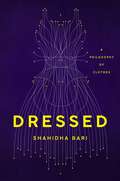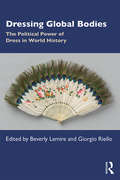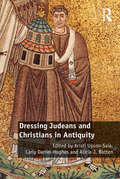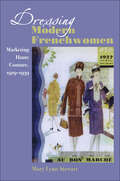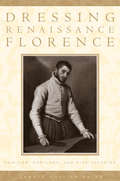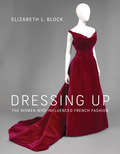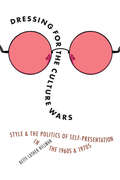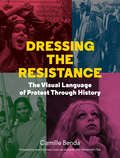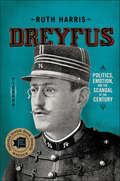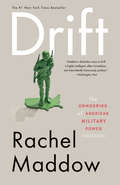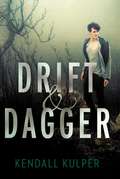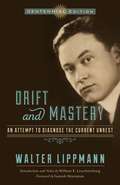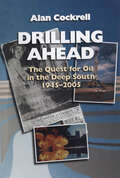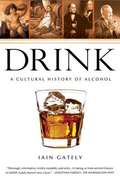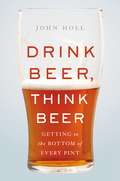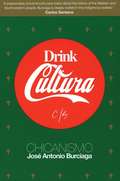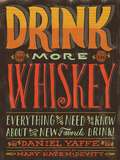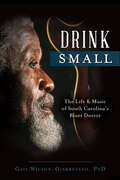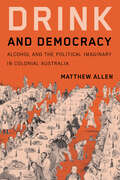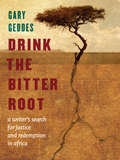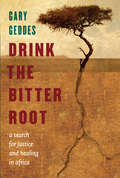- Table View
- List View
Dressed to Kill (A Kate O'Donnell Mystery #3)
by Patricia HallPhotographer Kate O&’Donnell, fresh from her adventures in Death Trap, discovers that modeling can be murder in Swinging Sixties London. It&’s 1963. A new band called the Rolling Stones is beginning to make its mark and the miniskirt is coming into fashion. For young Liverpudlian photographer Kate O&’Donnell, it&’s an exciting time to be in the capital—especially as she&’s on secondment to an up-and-coming fashion photographer&’s studio. But there&’s a sordid side to 1960s London, Kate discovers, when the naked, battered body of a teenage prostitute is found amongst the rubbish bins behind a Soho jazz club—and it turns out the victim was a former model at the studio where Kate&’s working. When a second young model disappears, Kate enlists her friend DS Harry Barnard&’s help to find out exactly what&’s going on. Together, they uncover the first of several dark secrets surrounding Andrei Lubin&’s fashion studio and the notorious Jazz Cellar. &“A likable heroine, an unusual plot, and plenty of unexpected twists make for an intriguing read.&” —Booklist &“Hall does a fine job of creating a groundbreaking protagonist whose fearlessness coupled with her talent forges a path for future female professionals.&” —Library Journal
Dressed: A Philosophy of Clothes
by Shahidha BariPerfect for readers of Women in Clothes, this beautifully designed philosophical guide to fashion explores art, literature, and film to uncover the hidden meaning of a well-chosen wardrobe.We all get dressed. But how often do we pause to think about what our clothes say? When we dress ourselves, we are presenting to the world an essence of who we are, who we want to be.Dressed ranges freely from suits to suitcases, from Marx's coat to Madame X's gown. Through art and literature, film and philosophy, philosopher Shahidha Bari unveils the surprising personal implications of what we choose to wear. The impeccable cut of Cary Grant's suit projects masculine confidence, just as Madonna's oversized denim jacket and her armful of orange bangles loudly announces big ambition. How others dress tells us something fundamental about them -- we can better understand how people live and what they think through their garments. Clothes tell our stories.Dressed is the thinking person's fashion book. In baring the hidden power of clothes in our culture and our daily lives, Bari reveals how our outfits not only cover our bodies but also reflect our minds.
Dressing Global Bodies: The Political Power of Dress in World History
by Giorgio Riello Beverly LemireDressing Global Bodies addresses the complex politics of dress and fashion from a global perspective spanning four centuries, tying the early global to more contemporary times, to reveal clothing practice as a key cultural phenomenon and mechanism of defining one’s identity. This collection of essays explores how garments reflect the hierarchies of value, collective and personal inclinations, religious norms and conversions. Apparel is now recognized for its seminal role in global, colonial and post-colonial engagements and for its role in personal and collective expression. Patterns of exchange and commerce are discussed by contributing authors to analyse powerful and diverse colonial and postcolonial practices. This volume rejects assumptions surrounding a purportedly all-powerful Western metropolitan fashion system and instead aims to emphasize how diverse populations seized agency through the fashioning of dress. Dressing Global Bodies contributes to a growing scholarship considering gender and race, place and politics through the close critical analysis of dress and fashion; it is an indispensable volume for students of history and especially those interested in fashion, textiles, material culture and the body across a wide time frame.
Dressing Judeans and Christians in Antiquity
by Carly Daniel-Hughes Alicia J. Batten Kristi Upson-SaiaThe past two decades have witnessed a proliferation of scholarship on dress in the ancient world. These recent studies have established the extent to which Greece and Rome were vestimentary cultures, and they have demonstrated the critical role dress played in communicating individuals’ identities, status, and authority. Despite this emerging interest in ancient dress, little work has been done to understand religious aspects and uses of dress. This volume aims to fill this gap by examining a diverse range of religious sources, including literature, art, performance, coinage, economic markets, and memories. Employing theoretical frames from a range of disciplines, contributors to the volume demonstrate how dress developed as a topos within Judean and Christian rhetoric, symbolism, and performance from the first century BCE to the fifth century CE. Specifically, they demonstrate how religious meanings were entangled with other social logics, revealing the many layers of meaning attached to ancient dress, as well as the extent to which dress was implicated in numerous domains of ancient religious life.
Dressing Modern Frenchwomen: Marketing Haute Couture, 1919–1939
by Mary Lynn StewartAt a glance, high fashion and feminism seem unlikely partners. Between the First and Second World Wars, however, these forces combined femininity and modernity to create the new, modern French woman. In this engaging study, Mary Lynn Stewart reveals the fashion industry as an integral part of women's transition into modernity. Analyzing what female columnists in fashion magazines and popular women novelists wrote about the "new silhouette," Stewart shows how bourgeois women feminized the more severe, masculine images that elite designers promoted to create a hybrid form of modern that both emancipated women and celebrated their femininity. She delves into the intricacies of marketing the new clothes and the new image to middle-class women and examines the nuts and bolts of a changing industry—including textile production, relationships between suppliers and department stores, and privacy and intellectual property issues surrounding ready-to-wear couture designs. Dressing Modern Frenchwomen draws from thousands of magazine covers, advertisements, fashion columns, and features to uncover and untangle the fascinating relationships among the fashion industry, the development of modern marketing techniques, and the evolution of the modern woman as active, mobile, and liberated.
Dressing Renaissance Florence: Families, Fortunes, and Fine Clothing (The Johns Hopkins University Studies in Historical and Political Science #120)
by Carole Collier FrickAs portraits, private diaries, and estate inventories make clear, elite families of the Italian Renaissance were obsessed with fashion, investing as much as forty percent of their fortunes on clothing. In fact, the most elaborate outfits of the period could cost more than a good-sized farm out in the Mugello. Yet despite its prominence in both daily life and the economy, clothing has been largely overlooked in the rich historiography of Renaissance Italy. In Dressing Renaissance Florence, however, Carole Collier Frick provides the first in-depth study of the Renaissance fashion industry, focusing on Florence, a city founded on cloth, a city of wool manufacturers, finishers, and merchants, of silk dyers, brocade weavers, pearl dealers, and goldsmiths. From the artisans who designed and assembled the outfits to the families who amassed fabulous wardrobes, Frick's wide-ranging and innovative interdisciplinary history explores the social and political implications of clothing in Renaissance Italy's most style-conscious city.Frick begins with a detailed account of the industry itself—its organization within the guild structure of the city, the specialized work done by male and female workers of differing social status, the materials used and their sources, and the garments and accessories produced. She then shows how the driving force behind the growth of the industry was the elite families of Florence, who, in order to maintain their social standing and family honor, made continuous purchases of clothing—whether for everyday use or special occasions—for their families and households. And she concludes with an analysis of the clothes themselves: what pieces made up an outfit; how outfits differed for men, women, and children; and what colors, fabrics, and design elements were popular. Further, and perhaps more basically, she asks how we know what we know about Renaissance fashion and looks to both Florence's sumptuary laws, which defined what could be worn on the streets, and the depiction of contemporary clothing in Florentine art for the answer.For Florence's elite, appearance and display were intimately bound up with self-identity. Dressing Renaissance Florence enables us to better understand the social and cultural milieu of Renaissance Italy.
Dressing Up: The Women Who Influenced French Fashion
by Elizabeth L. BlockHow wealthy American women--as consumers and as influencers--helped shape French couture of the late nineteenth century; lavishly illustrated.French fashion of the late nineteenth century is known for its allure, its ineffable chic--think of John Singer Sargent's Madame X and her scandalously slipping strap. For Parisian couturiers and their American customers, it was also serious business. In Dressing Up, Elizabeth Block examines the couturiers' influential clientele--wealthy American women who bolstered the French fashion industry with a steady stream of orders from the United States. Countering the usual narrative of the designer as solo creative genius, Block shows that these women--as high-volume customers and as pre-Internet influencers--were active participants in the era's transnational fashion system.Block describes the arrival of nouveau riche Americans on the French fashion scene, joining European royalty, French socialites, and famous actresses on the client rosters of the best fashion houses--Charles Frederick Worth, Doucet, and Félix, among others. She considers the mutual dependence of couture and coiffure; the participation of couturiers in international expositions (with mixed financial results); the distinctive shopping practices of American women, which ranged from extensive transatlantic travel to quick trips downtown to the department store; the performance of conspicuous consumption at balls and soirées; the impact of American tariffs on the French fashion industry; and the emergence of smuggling, theft, and illicit copying of French fashions in the American market as the middle class emulated the preferences of the rich. Lavishly illustrated, with vibrant images of dresses, portraits, and fashion plates, Dressing Up reveals the power of American women in French couture.Winner of the Aileen Ribeiro Grant of the Association of Dress Historians; an Association for Art History grant; and a Pasold Research Fund grant.
Dressing for the Culture Wars: Style and the Politics of Self-Presentation in the 1960s and 1970s
by Betty Luther HillmanStyle of dress has always been a way for Americans to signify their politics, but perhaps never so overtly as in the 1960s and 1970s. Whether participating in presidential campaigns or Vietnam protests, hair and dress provided a powerful cultural tool for social activists to display their politics to the world and became both the cause and a symbol of the rift in American culture. Some Americans saw stylistic freedom as part of their larger political protests, integral to the ideals of self-expression, sexual freedom, and equal rights for women and minorities. Others saw changes in style as the erosion of tradition and a threat to the established social and gender norms at the heart of family and nation. <p><p> Through the lens of fashion and style, Dressing for the Culture Wars guides us through the competing political and social movements of the 1960s and 1970s. Although long hair on men, pants and miniskirts on women, and other hippie styles of self-fashioning could indeed be controversial, Betty Luther Hillman illustrates how self-presentation influenced the culture and politics of the era and carried connotations similarly linked to the broader political challenges of the time. Luther Hillman’s new line of inquiry demonstrates how fashion was both a reaction to and was influenced by the political climate and its implications for changing norms of gender, race, and sexuality.
Dressing the Resistance: The Visual Language of Protest
by Camille BendaDressing the Resistance is a celebration of how we use clothing, fashion, and costume to ignite activism and spur social change.Weaving together historical and current protest movements across the globe, Dressing the Resistance explores how everyday people and the societies they live in harness the visual power of dress to fight for radical change. American suffragettes made and wore dresses from old newspapers printed with voting slogans. Male farmers in rural India wore their wives' saris while staging sit-ins on railroad tracks against government neglect. Costume designer and dress historian Camille Benda analyzes cultural movements and the clothes that defined them through nearly 200 archival images, photographs, and paintings that bring each event to life, from ancient Roman rebellions to the #MeToo movement, from twentieth century punk subcultures to Black Lives Matter marches.
Dreyfus: Politics, Emotion, and the Scandal of the Century
by Ruth HarrisThe definitive history of the infamous scandal that shook a nation and stunned the worldIn 1894, Alfred Dreyfus, a Jewish officer in the French army, was wrongfully convicted of being a spy for Germany and imprisoned on Devil's Island. Over the following years, attempts to correct this injustice tore France apart, inflicting wounds on the society which have never fully healed. But how did a fairly obscure miscarriage of justice come to break up families in bitterness, set off anti-Semitic riots across the French empire, and nearly trigger a coup d'état? How did a violently reactionary, obscurantist attitude become so powerful in a country that saw itself as the home of enlightenment? Why did the battle over a junior army officer occupy the foremost writers and philosophers of the age, from Émile Zola to Marcel Proust, Émile Durkheim, and many others? What drove the anti-Dreyfusards to persist in their efforts even after it became clear that much of the prosecution's evidence was faked?Drawing upon thousands of previously unread and unconsidered sources, prizewinning historian Ruth Harris goes beyond the conventional narrative of truth loving democrats uniting against proto-fascists. Instead, she offers the first in-depth history of both sides in the Affair, showing how complex interlocking influences—tensions within the military, the clashing demands of justice and nationalism, and a tangled web of friendships and family connections—shaped both the coalition working to free Dreyfus and the formidable alliances seeking to protect the reputation of the army that had convicted him. Sweeping and engaging, Dreyfus offers a new understanding of one of the most contested and significant moments in modern history.
Drift
by Rachel MaddowThe #1 New York Times bestseller that charts America's dangerous drift into a state of perpetual war. "One of my favorite ideas is, never to keep an unnecessary soldier," Thomas Jefferson wrote in 1792. Neither Jefferson nor the other Founders could ever have envisioned the modern national security state, with its tens of thousands of "privateers"; its bloated Department of Homeland Security; its rusting nuclear weapons, ill-maintained and difficult to dismantle; and its strange fascination with an unproven counterinsurgency doctrine. Written with bracing wit and intelligence, Rachel Maddow's Drift argues that we've drifted away from America's original ideals and become a nation weirdly at peace with perpetual war, with all the financial and human costs that entails. To understand how we've arrived at such a dangerous place, Maddow takes us from the Vietnam War to today's war in Afghanistan, along the way exploring the disturbing rise of executive authority, the gradual outsourcing of our war-making capabilities to private companies, the plummeting percentage of American families whose children fight our constant wars for us, and even the changing fortunes of G.I. Joe. She offers up a fresh, unsparing appraisal of Reagan's radical presidency. Ultimately, she shows us just how much we stand to lose by allowing the priorities of the national security state to overpower our political discourse. Sensible yet provocative, dead serious yet seriously funny, Drift will reinvigorate a "loud and jangly" political debate about how, when, and where to apply America's strength and power--and who gets to make those decisions.From the Hardcover edition.
Drift & Dagger
by Kendall KulperIn Mal's world, magic is everything. But Mal is a "blank," the anti-magic. Blanks can't be hexed or cursed or saved or killed by magic. And everyone is afraid of them--even Mal himself.So Mal hides what he is--except from Essie Roe, a witch and his best friend. On the day Essie reveals his secret and casts him out from the only home he's ever known, Mal experiences the true shock of betrayal.Now Mal travels the world in search of rare, illegal magical relics. When his partner in crime, Boone, hears rumors of a legendary dagger that can steal a witch's power, Mal knows he's finally found his means of revenge. But as the chase for the fabled knife takes them from Boston to Paris to Constantinople, Mal realizes there are secrets afoot that he's only beginning to understand--and all the while the blank monster inside him threatens to escape.
Drift and Mastery
by Walter LippmannDrift and Mastery, originally published in 1914, is one of the most important and influential documents of the Progressive Movement, a valuable text for understanding the political thought of early twentieth-century America. This paperback edition of Walter Lippmann's classic work includes a revised introduction by William E. Leuchtenburg that places the book in its historical and political contexts. In his first book, A Preface to Politics, Lippmann was sharply critical of traditionalism in favor of creativity--so much so that he was accused of anti-intellectualism. In Drift and Mastery, he corrected this imbalance, exploring the tensions between expansion and consolidation, traditionalism an progressivism, emotion and rationality. He wrote to convince readers that they could balance these tensions: they could be organized, efficient, and functional without sacrificing impulse, choice, fantasy, or liberty. Mastery is attainable, Lippmann argued, but scientific endeavor is driven by human curiosity and creativity--an argument in favor of science as both a method as both a method for discovering the truth and a means of wish fulfillment through diligent attention to facts. Drift and Mastery is both a telling product of its times and a lucid exploration of timeless themes in American government and politics. It will continue to serve new generations of scholars and students in American intellectual history, mass communications, and political science.
Drift: The Unmooring of American Military Power (Playaway Adult Nonfiction Ser.)
by Rachel MaddowThe #1 New York Times bestseller that charts America’s dangerous drift into a state of perpetual war. Written with bracing wit and intelligence, Rachel Maddow's Drift argues that we've drifted away from America's original ideals and become a nation weirdly at peace with perpetual war. To understand how we've arrived at such a dangerous place, Maddow takes us from the Vietnam War to today's war in Afghanistan, along the way exploring Reagan's radical presidency, the disturbing rise of executive authority, the gradual outsourcing of our war-making capabilities to private companies, the plummeting percentage of American families whose children fight our constant wars for us, and even the changing fortunes of G.I. Joe. Ultimately, she shows us just how much we stand to lose by allowing the scope of American military power to overpower our political discourse. Sensible yet provocative, dead serious yet seriously funny, Drift will reinvigorate a "loud and jangly" political debate about our vast and confounding national security state.
Drilling Ahead: The Quest for Oil in the Deep South, 1945–2005
by Alan CockrellThe discovery of oil in Tinsley, Mississippi, in 1939 captivated the South and has deeply affected the region ever since. At the end of 1940, over 133 wells were flowing, and speculators were drilling holes and staking claims all along the Gulf Coast and its immediate environs. Consequently, the region's economy, ecosystems, and politics have been shaped by black gold since the end of World War II. Alan Cockrell, a petroleum geologist, provides an insider's account of the science of oil hunting, the political processes that help or hinder it, and the advances in technology that make it all possible. This book documents the ways in which wars, foreign competition, governmental regulation, and new business models affect oil exploration, and what that means to the South's people. Just as significantly, Cockrell provides compelling commentary on the people who hunt for petroleum, from pioneering wildcatters such as Chesley Pruet to savvy geologists focusing on science and technology Drilling Ahead documents the triumphs and travails of oil hunters. Mavericks, underworld characters, professors, lawyers, and environmentalists have all played major roles in the South's oil production. A fascinating study of corporations, economies, and people, Drilling Ahead is a compelling, opinionated narrative as well as an exhaustively researched history.Published for the Mississippi Geological Society
Drink
by Iain GatelyA spirited look at the history of alcohol, from the dawn of civilization to the modern day Alcohol is a fundamental part of Western culture. We have been drinking as long as we have been human, and for better or worse, alcohol has shaped our civilization. Drink investigates the history of this Jekyll and Hyde of fluids, tracing mankind's love/hate relationship with alcohol from ancient Egypt to the present day. Drink further documents the contribution of alcohol to the birth and growth of the United States, taking in the War of Independence, the Pennsylvania Whiskey revolt, the slave trade, and the failed experiment of national Prohibition. Finally, it provides a history of the world's most famous drinks-and the world's most famous drinkers. Packed with trivia and colorful characters, Drink amounts to an intoxicating history of the world.
Drink Beer, Think Beer: Getting to the Bottom of Every Pint
by John HollFrom an award-winning journalist and beer expert, a thoughtful and witty guide to understanding and enjoying beerRight here, right now is the best time in the history of mankind to be a beer drinker. America now has more breweries than at any time since prohibition, and globally, beer culture is thriving and constantly innovating. Drinkers can order beer brewed with local yeast or infused with moondust. However, beer drinkers are also faced with uneven quality and misinformation about flavors. And the industry itself is suffering from growing pains, beset by problems such as unequal access to taps, skewed pricing, and sexism. Drawing on history, economics, and interviews with industry insiders, John Holl provides a complete guide to beer today, allowing readers to think critically about the best beverage in the world. Full of entertaining anecdotes and surprising opinions, Drink Beer, Think Beer is a must-read for beer lovers, from casual enthusiasts to die-hard hop heads.
Drink Cultura: Chicanismo
by José Antonio BurciagaThis book is about the Chicano experience of living within, between and sometimes outside of two cultures -- the damnation and salvation, and the celebration of it all.
Drink Like a Woman: Shake. Stir. Conquer. Repeat.
by Jeanette HurtCocktail marketers and male bartenders like to tell women what we want to drink-and it’s usually fruity, frilly, fancy, and pink. In Drink Like a Woman, Jeanette Hurt shakes up barroom expectations, stirs up some new ideas, and pours a lively collection of feminist cocktails that are just as varied, flavorful, and strong as women are. Sharing basic techniques, cocktail classics, hangover cures, drinking games, and more, this spirited guide takes the misogyny out of mixology by offering fun and functional tips for the at-home barista who doesn’t need a man to mix it up. She also exposes the surprisingly sexist history of cocktail culture, and offers more than 50 recipes, crafted by top women bartenders around the country, including: Anarchy AmarettoBloody Mary RichardsNelly Bly-TaiThe LBD (The Little Black Dress)Ruth’s Pink TabooWoManhattanZeldatiniThe Suffragette SourRide, Sally RideCurie Royale With feisty illustrations and original recipes that call for a generous splash of female empowerment, Drink Like a Woman is sure to subvert the patriarchy, one drink at a time.
Drink More Whiskey
by Mary Kate Mcdevitt Daniel YaffeThis smart guide to whiskey introduces a new generation of would-be connoisseurs to the hottest new-again spirit. And with upstart distillers reviving varieties like white dog (moonshine to prohibition-era folks), now is the best time to start learning about it. Drink More Whiskey is the reference for those want to discover the provenance, styles, differences in quality, and ideal uses of whiskey in a fresh, fun-to-read format. In addition, more than 20 recipes are sprinkled throughout, from classics like the Old Fashioned to thoroughly modern tipples like the Manchester (made from single malt Scotch whisky and fresh herbs), so readers can take their learning from book to glass.
Drink Small: The Life & Music of South Carolina's Blues Doctor (Music Ser.)
by Gail Wilson-Giarratano PhDFor fans of the blues, Drink Small is synonymous with South Carolina. Drink rose from the cotton fields of Bishopville to become a music legend in the Palmetto State and beyond. The self-taught guitarist has written hundreds of songs and recorded dozens of albums spanning the genres of country, blues, folk, gospel and shag. The success of that music allowed him countless honors, such as playing the stages of the Apollo and Howard Theaters, touring with legendary R&B singer Sam Cooke and playing the best blues festivals in the world. He even developed his own philosophy: Drinkism. Author Gail Wilson-Giarratano details the dream, the music and the life that created the Blues Doctor.
Drink and Democracy: Alcohol and the Political Imaginary in Colonial Australia (Intoxicating Histories)
by Matthew AllenThe nineteenth-century spread of democracy in Britain and its colonies coincided with an increase in alcohol consumption and in celebratory public dinners with rounds of toasts. British colonists raised their glasses to salute the Crown in rituals that asserted fraternal equality and political authority. Yet these ceremonies were reserved for gentlemen, leaving others – notably women and Indigenous people – on the political margins.Drink and Democracy traces the development of democratic ideas in New South Wales through the history of public drinking and temperance. As the colony transformed from a convict autocracy to a liberal democracy, Matthew Allen argues, public drinking practices shaped the character of the emerging political order. The ritual of toasting was a symbolic display of restraint – drunkenness without loss of self-control – that embodied the claim to citizenship of white male settlers. Yet the performative sobriety of the temperance movement was also democratic, a display of respectability that politicized its supporters around a rival vision of responsible citizenship. Drink was a way to police the limits of the political realm. The stigma of female drunkenness worked to exclude women from the public sphere, while perceptions of heavy drinking among Aboriginal people cast them as lacking self-control and hence unworthy of political rights.Drink and Democracy reveals that long before the introduction of the franchise, colonists in Australia imagined themselves as citizens. Yet even as democracy expanded, drink marked its limits.
Drink in the Eighteenth and Nineteenth Centuries (Perspectives in Economic and Social History #29)
by Susanne Schmid Barbara Schmidt-HaberkampThis collection of essays covers the representation and practice of drinking a variety of beverages across eighteenth- and nineteenth-century Britain and North America. The case studies in this volume cover drinking culture from a variety of perspectives, including literature, history, anthropology and the history of medicine.
Drink the Bitter Root
by Gary GeddesDrink the Bitter Root is an international story about the ethical and environmental footprint world nations are leaving in Africa in their determined efforts to destabilize and loot the continent. In the spirit of Robert Kaplan and Samantha Power, Gary Geddes sets out in search of justice, healing and reconciliation. He begins his journey at the International Criminal Court in The Hague, then travels to Rwanda, Uganda, the Democratic Republic of Congo, Ethiopia and Somaliland, crossing Lake Victoria and the Great Rift Valley, where human life began. Geddes's quest takes the form of an intimate personal travelogue. Although he confronts the dark realities of abduction, rape, mutilation and murder, drawing on painful encounters, interviews and adventures that occur along the way, Geddes also brings back amazing stories of survival and unexpected moments of grace. His poet's eye and self-deprecating humor draw us ever more deeply into the lives of some amazing Africans, while never forgetting the complicity we all feel in the face of tragic events unfolding there.In the words of author and Africanist Ian Smillie, Drink the Bitter Root is not only poignant, literate and funny, but also "a deeply textured journey without maps into the unexplored rifts of sub-Saharan Africa, the human experience, and the psyche. It's also the masterful handling of a full palette."
Drink the Bitter Root: A Search for Justice and Healing in Africa
by Gary GeddesDrink the Bitter Root is an international story about the ethical and environmental footprint world nations are leaving in Africa in their determined efforts to destabilize and loot the continent. In the spirit of Robert Kaplan and Samantha Power, Gary Geddes sets out in search of justice, healing and reconciliation. He begins his journey at the International Criminal Court in The Hague, then travels to Rwanda, Uganda, the Democratic Republic of Congo, Ethiopia and Somaliland, crossing Lake Victoria and the Great Rift Valley, where human life began. Geddes's quest takes the form of an intimate personal travelogue. Although he confronts the dark realities of abduction, rape, mutilation and murder, drawing on painful encounters, interviews and adventures that occur along the way, Geddes also brings back amazing stories of survival and unexpected moments of grace. His poet's eye and self-deprecating humor draw us ever more deeply into the lives of some amazing Africans, while never forgetting the complicity we all feel in the face of tragic events unfolding there.In the words of author and Africanist Ian Smillie, Drink the Bitter Root is not only poignant, literate and funny, but also "a deeply textured journey without maps into the unexplored rifts of sub-Saharan Africa, the human experience, and the psyche. It's also the masterful handling of a full palette."

